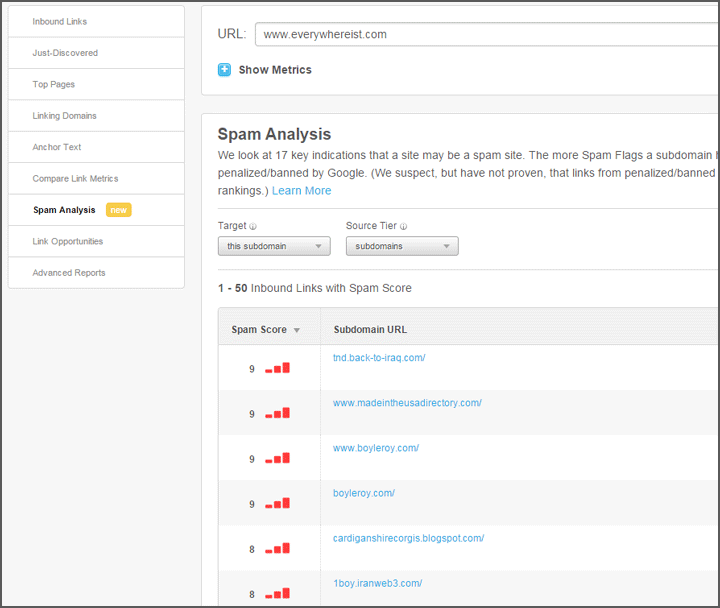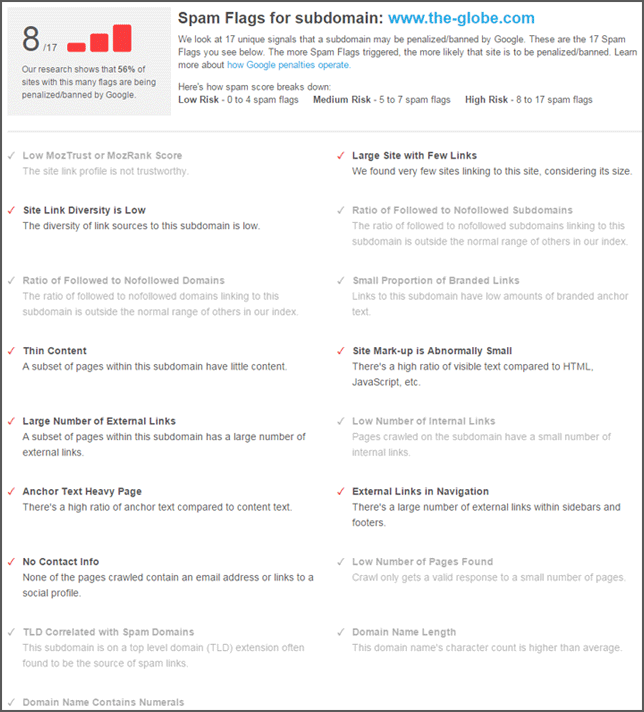Moz Open Site Explorer Adds Spam Analysis For Risky Links
Popular SEO tool software company, Moz, launched a spam analysis feature within their link analysis toolset.
Moz announced a new feature around their Open Site Explorer link analysis tool where paid subscribers can view a new section called “spam analysis.”
Spam Analysis within Open Site Explorer aims at documenting and uncovering the more risky and penalty prone links pointing to your web site. It goes as far as helping you build a disavow file to upload to Google.
The tool is similar to many link tools but the spam analysis resembles LinkResearchTools.com the most.
Here are some screen shots shared by the Moz blog showing the reports:
The tool uses 17 different flag spam classifications and the more flags associated with a site, the more Moz will classify the risk. What are the flags? Here are some as they are defined now by Moz:
- Low mozTrust to mozRank ratio: Sites with low mozTrust compared to mozRank are likely to be spam.
- Large site with few links: Large sites with many pages tend to also have many links and large sites without a corresponding large number of links are likely to be spam.
- Site link diversity is low: If a large percentage of links to a site are from a few domains it is likely to be spam.
- Ratio of followed to nofollowed subdomains/domains (two separate flags): Sites with a large number of followed links relative to nofollowed are likely to be spam.
- Small proportion of branded links (anchor text): Organically occurring links tend to contain a disproportionate amount of banded keywords. If a site does not have a lot of branded anchor text, it’s a signal the links are not organic.
- Thin content: If a site has a relatively small ratio of content to navigation chrome it’s likely to be spam.
- Site mark-up is abnormally small: Non-spam sites tend to invest in rich user experiences with CSS, Javascript and extensive mark-up. Accordingly, a large ratio of text to mark-up is a spam signal.
- Large number of external links: A site with a large number of external links may look spammy.
- Low number of internal links: Real sites tend to link heavily to themselves via internal navigation and a relative lack of internal links is a spam signal.
- Anchor text-heavy page: Sites with a lot of anchor text are more likely to be spam then those with more content and less links.
- External links in navigation: Spam sites may hide external links in the sidebar or footer.
- No contact info: Real sites prominently display their social and other contact information.
- Low number of pages found: A site with only one or a few pages is more likely to be spam than one with many pages.
- TLD correlated with spam domains: Certain TLDs are more spammy than others (e.g. pw).
- Domain name length: A long subdomain name like “bycheapviagra.freeshipping.onlinepharmacy.com” may indicate keyword stuffing.
- Domain name contains numerals: domain names with numerals may be automatically generated and therefore spam.
Here is the scale on how many flags it takes to get risky:
Related stories
New on Search Engine Land



